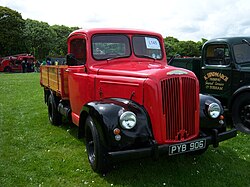Morris LC
| Morris LC | |
|---|---|
| Manufacturer: | Morris Motor Company |
| Production period: | 1937-1960 |
| Previous model: | |
| Successor: | Morris FG |
The Morris LC truck was originally built as a panel van and flatbed truck by Morris Commercial , the commercial vehicle division of the Morris Motor Company, as a smaller alternative to the Morris P-type . After the merger with Austin Motors to form the British Motor Corporation in 1953, it was only built as a flatbed truck, chassis and tractor unit and also as an Austin 301 , while the other variants were replaced by the Morris LD Van . 1960 replaced the model of the Morris FG .
Morris LC1 1937-1948, Morris LC3 1948-1952
| Morris LC1 / LC3 | |
|---|---|

|
|
| Production period: | 1937-1952 |
| Engines: | Petrol engine : 2050 cm³ |
| Payload: | 1250-1500 tons |
The first generation of the LC started in 1937 as a 25/30-cwt transporter and truck. 25/30-cwt refers to the payload of 1250 to 1500 kg. Many technical components were taken over by the LC from the Morris P-Type, this had a payload of 2 to 2.5 tons, and the LC should round it off at the bottom. Below the P-type there were only delivery vans from Morris based on the passenger car models such as the Morris Eight or the Morris Ten . These had a maximum payload of 1000 kg, and the possibility of developing a comprehensive commercial vehicle from them was naturally limited. The Morris LC was therefore included in the range as a panel van, flatbed truck and tractor unit. Even ambulances and buses were realized on the chassis. The drive was taken over by a 2050 cm³ four-cylinder petrol engine with an output of 31 kW / 42 hp. The British Army ordered many models; after the outbreak of World War II , civilian production was discontinued and only variants were produced for the Army. As a result of conquest, models of the LC also came into the hands of the German Wehrmacht . After the end of the war, production was resumed for civil use, but only chassis for superstructures, flatbeds and tractor units.
Morris LC3 1948-1952
In 1948 the revised model was presented as the LC3. In addition to small visual changes, the electrical system has been improved. From now on, panel vans and buses were offered again. Morris built the LC3 until March 1952.
Morris LC4 1952-1953, Morris LC5 1954-1960, Austin 301 1953-1957
| Morris LC4 / LC5 Austin 301 |
|
|---|---|

|
|
| Production period: | 1953-1960 |
| Engines: |
Petrol engine : 2199 cm³ Diesel engine : 3400 cm³ |
| Payload: | 1250-1500 tons |
In April 1952 the Morris LC4 was presented. It had a redesigned front and now an all-steel cab. To provide fresh air to the cabin, adjustable flaps and slots were now incorporated below the windshield and in the roof. The heating system had been improved and its fan could now distribute the incoming fresh air. The 3-seater bench now offered an adjustable section for the driver, whose seat had reinforced upholstery. For the first time, there were lockable doors with recessed grips in the interior doors. In the export models, hydraulic shock absorbers were standard all round, which were offered as an option in the home market. The size of the wheels had also changed to reflect the post-war trend towards smaller diameters. Initially, the entire body variety of the predecessor was available. The drive was taken over by the Austin A70 4-cylinder petrol engine with 2199 cm³ and 45 kW / 61 PS, the power of which was transmitted to the rear axle by means of a 4-speed manual gearbox via a cardan shaft.
Morris LC5 1954-1960, Austin 301 1953-1957
In 1952, Morris and Austin Motors merged to form BMC . Therefore, from 1953, the Austin 301 was derived from the Morris LC4 by means of badge engineering . Since the Morris LD Van appeared at the same time , there were now only chassis for bodywork, flatbed trucks or tractor units with a payload of 1500 kg. 1954 was the first time a 3400 cc 4-cylinder diesel engine with 49 kW / 68 hp was available as an option, initially as an LC5 version. As of summer, the entire line was referred to as the Morris LC5.
The Austin 301 was produced until 1957 and had no successor. Production of the Morris LC5 continued until 1960 when it was replaced by the Morris FG .

